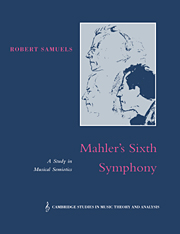Book contents
3 - Coding of musical form: the Finale
Published online by Cambridge University Press: 17 November 2009
Summary
In the previous chapter, the consideration of motivic processes as coded signifying structures demonstrated many of the advantages (and problems) inherent in the definition of music as a semiotic system. Nevertheless, it remains true that the limitation of the analysis to structures of pitch and duration, which are immanent within and unique to the individual work, begs the question of whether the conceptual armoury of code and sign production can address the much hazier issue of how the musical work is to be situated within the contexts and histories of other examples of cultural production. Whilst certain intertextual observations can be made about motivic coding (the establishment of an idiolect, or the latent reference to previous works), and certain extramusical signifieds can tentatively be suggested (the tendency to decay and dissolution, the Utopian breakthrough of the E major passage), other codes are needed to bring the individual work into relationship with specific traditions of composition. The obvious candidate with which to begin this inquiry is the coding of musical form. To the extent to which formal archetypes can be identified in a piece of music, they necessarily invoke some sort of relationship with the previous history of the use of that form. Frequently, in works of the late nineteenth century and early twentieth century, specific earlier composers, or indeed individual works, can be named by formal process alone. For instance, the kinship between Mahler's Second Symphony and Beethoven's Ninth concerns much more than just the use of a chorus.
- Type
- Chapter
- Information
- Mahler's Sixth SymphonyA Study in Musical Semiotics, pp. 64 - 90Publisher: Cambridge University PressPrint publication year: 1995



